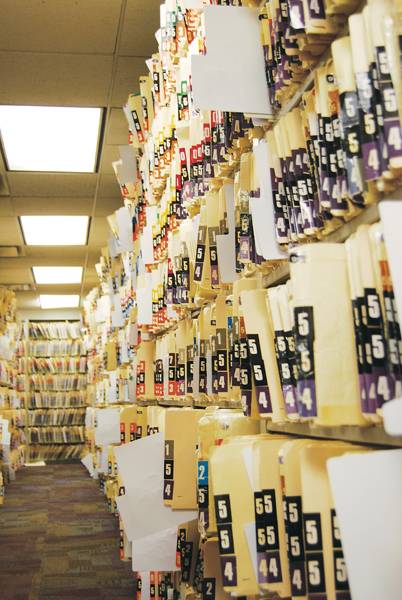McFarland Clinic goes digital

The McFarland Clinic record space holds about 280,000 files from 1946 to Nov. 2009. The clinic has started scanning the records to a digital format for the electronic medical records system that can be accessed from other McFarland locations. Photo: Christine Naulty/Iowa State Daily
January 10, 2010
By the end of 2010, doctors and nurses at McFarland Clinic, 1215 Duff Ave., won’t need paper charts for patient records. All information will be stored electronically, and doctors will have years of patient information instantaneously at their fingertips.
When a patient walks into McFarland Clinic today, a complex, choreographed set of actions takes place. The patient is matched to a six-digit number that corresponds to the placement of his or her chart.
Using that six-digit number as a map, a records specialist will find and retrieve the files from a massive basement room filled with tens of thousands of files. If the patient hasn’t been to the clinic in more than three years, the process is even more complex, because the record will be in an off-site archive and will need to be physically moved to Ames.
The McFarland system has thousands of square feet dedicated to storage and approximately 280,000 patient files.
But soon, those paper charts won’t be need to be pulled at all.
“There will be a point in the future — and we anticipate that being sometime [in] the third or fourth quarter of 2010 — that the paper record will not be necessary when a patient is seen,” said Roger Kluesner, chief operating officer for McFarland. “Some of our physicians are already saying, ‘Don’t take the time to pull that paper chart. I have everything I need in the electronic records system.’”
Installation of the system began about a year-and-a-half ago. Hardware was put in place and software was populated with about five years of patient notes, lab tests and radiology results that already existed in digital format.
Then the clinic had to invest significantly in training.
“There are people at various stages of comfort level in terms of working on an electronic system,” said Shelley Goecke, marketing and public relations director for the clinic. “From the very beginning we were doing a lot of keyboard testing and skill assessment.”
Once doctors and nurses were comfortable, they began putting new information into the system. Over time, as patients are seen by the clinic, staff have transferred remaining information out of the paper charts.
On Nov. 16, 2009, the paper charts were frozen.
“There’s no new paper going into that paper chart,” Goecke said.
Kluesner estimated the system will cost the clinic $20 million over 10 years. McFarland may be eligible for some federal stimulus dollars, though, and the system will result in cost savings.
“When you don’t have the paper to buy, the paper to store, the paper to move around, that’s a huge cost savings both in physical expense and the labor costs,” Kluesner said.
McFarland is building a new clinic in north Ames that would normally have about 800 square feet dedicated to storing files, Kluesner said. But when the new clinic opens in September, it won’t even have a records room.
“This is the first time we have ever constructed or arranged for a medical office without a medical records room,” wrote Steve Koger, chief executive officer of McFarland Clinic, in a statement. “Radiology images in north Ames will also be completely digital. Our providers will review the digital images through computer access.”
It is this quick and easy access that makes the system so attractive. Questions can be answered immediately instead of waiting for charts to arrive.
“The timeliness of response is increased dramatically,” Kluesner said. “If you’re the parent with a small child that’s ill, those minutes seem like hours and hours seem like days.”
In addition, the system will help overcome geographic and functional boundaries. McFarland has 32 specialties in 11 communities. The paper chart can only be in one place at a time.
“We’re coordinating patients’ care,” Goecke said. “So that’s a tremendous benefit for all those physicians in that network to be able to view off of that one record and see things in real time as results are coming in.”
The biggest difficulty facing doctors is maintaining successful conversation with patients while typing information into the system, said Dr. Donald Skinner, who practices family medicine at McFarland. He has laid out his exam rooms specifically to help ease the problem.
“I usually have my nurses have you sit in the chair, so you’re right next to me, so I can look you in the eye as I struggle with my typing,” Skinner said with a laugh.
For the most part, Skinner said, his patients welcome the system. New services, such as reminders for preventative care and a Web portal to let patients access their records online, will add value for both the clinic and the patient as the system evolves.
And if a doctor still wants to see that old paper chart, McFarland will have that, too.
“We’ll have it archived,” Kluesner said.






